Sunday, July 10 2016
As Q2’16 came to a close, this blog turned out to be completely different from what I had planned a week before. Of course, this quarter’s D-Day for stock markets all over the world was the vote by the Brits to leave the EU (the so-called BREXIT). With the Brits voting to leave, the worldwide performances for the quarter were severely damaged in one day. Compared to this, all other topics are boring. Since the BREXIT vote, the markets have rebounded some, but not with enough time to recover the entire BREXIT losses before the end of the 2nd quarter.
My fear is that the rebound is only temporary, simply because the “Market to Nowhere” (in the case the S&P 500) is approaching its VERY STRONG resistance level at its all-time closing high of 2135 (and its Intraday high of 2140) again. This is something that the market has tried to break, and failed to do, over ten times over the last 17 months.
This record flat tight-trading range should be the main topic of Q2’16 as it has been for over the last 18 months. There are some very serious reasons for this strange, rare market behavior. Take a few seconds to look at the graph below and concentrate on the blue rectangle on the top right. This blue consolidation pattern represents a FLAT trading range of roughly plus and minus of 2.4% for nearly one and one-half years, with two big drops in between. That is phenomenal and very rare. Remember, this means that when the market is in a tight pattern like this, and you do not trade at all during the entire period, it would not matter much if you stayed long, short, or in cash. On the other hand, if an investor tried to trade this market, they could have ended up getting whipsawed mercilessly.
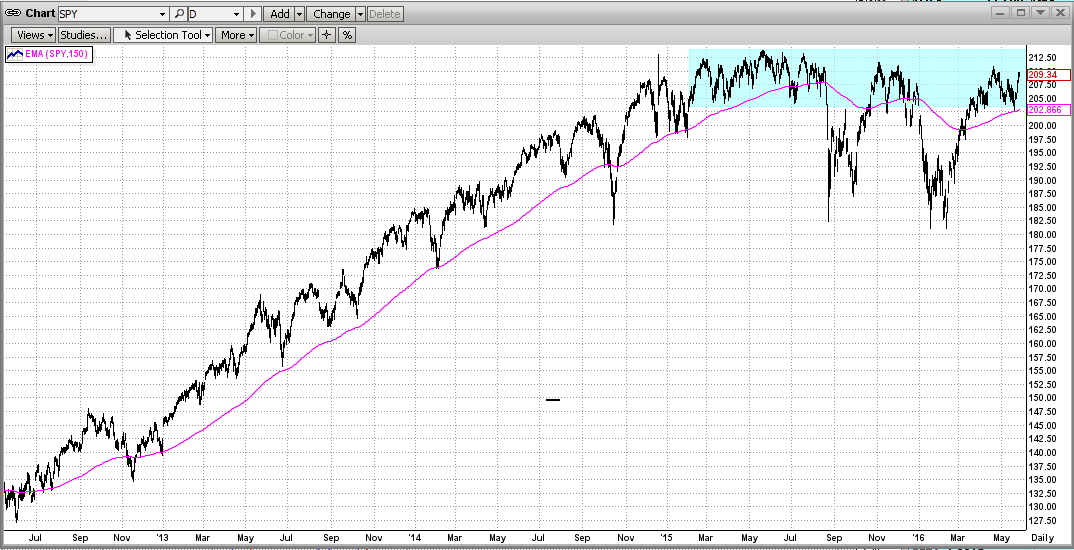
“Big Picture” Outlook
In the graph above, you can see that the two big moves to the downside, below the trend line and/or through the bottom of the blue trading pattern, were fast and deadly (that is, volatile and deep); whereas the moves to the upside got slapped back every time the market approached its all-time high. This says to me that most large investors may be expecting a big drop, and have little or no confidence in the market making new all-time highs.
Yellen’s Up Market
But, please do not underestimate the immense power that the “Master Market Manipulator” (Federal Yellen) has over the stock markets. If Yellen wants the market to go up (or at least to not go down), she will simply repeat what she has concocted to make her “black magic” successful over the last 7 years. This time, however, if the market does break to the upside, the sky is most likely the limit !!!
Extremely Strong Resistance
On the other hand, even with Yellen’s help, breaking the all-time high of 2140 on the S&P 500 will be like breaking through a 10-foot-wide steel wall. The Bears are lined up there with all of their guns loaded (sell orders) and are ready to fire when they can “see the whites of their eyes”. The end result of this could be another “topping pattern” as in 2000 and 2008 (see graph below).
In 2000 and 2008, the markets waffled (“topped”) in a tight consolidation pattern for 10-12 months before breaking to the downside and crashing 40-50%. In 2016, the market has been “topping” in a very similar trading range for almost 22 months, and could be getting ready to dive.
Be careful !!!
Preservation of Capital Rules...
 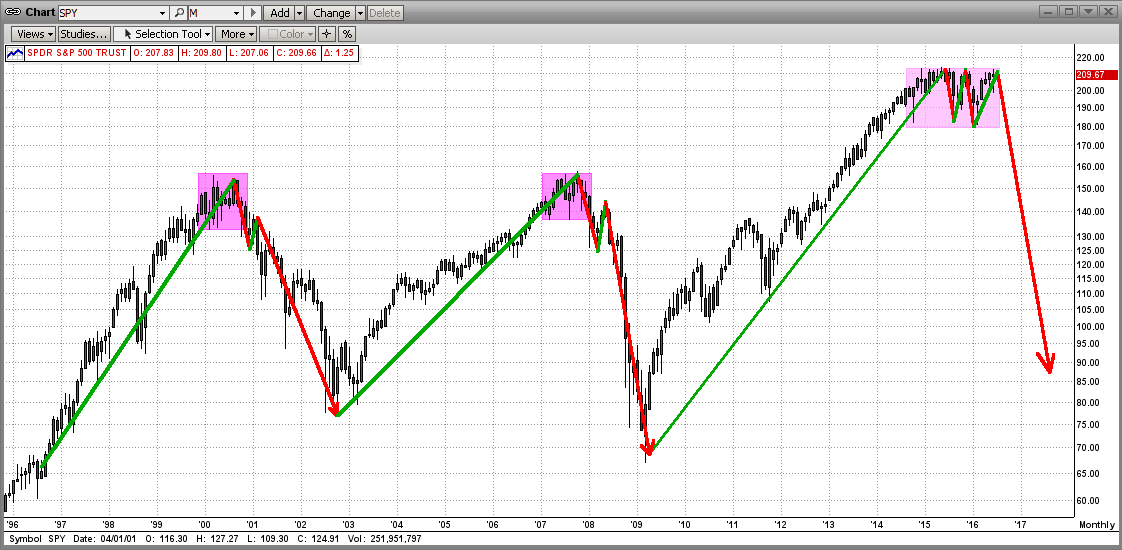
MIPS Models
After the big one-day “hit” from the BREXIT on 6/24/2016, the performance of our MIPS4 model:
a) trading 1.0x SPY Long and 1.0x SPY Short, and
b) trading 1.5x SPY Long and 1.0x SPY Short, and
were near breakeven for 2Q’16, but they remained up about +1.5 and +3.0% YTD in 2016, respectively.
Sunday, July 03 2016
We have acquired a lot of new MIPS members over the last 6 months, some of whom are not sure when to trade a new MIPS signal, especially over a weekend or holiday.
If you just remember this, you cannot go wrong...
- upon receipt of each new MIPS Signal Change email, you trade on the next available market opportunity.
For example:
- if you get a Signal Change email on Friday night, you trade the new Signal on Monday's open, or
- if you get a Signal Change email on Sunday night, you trade the new Signal on Monday's open, or
- if you get a Signal change email on Monday morning before the market opens, you trade on that open.
In all of the above cases, you would be trading the new MIPS Signal (if any) as of Firday's close.
For more, you can click the "Services" tab in the main menu and then click the blue button on the upper left entitled "How/When to Trade"; or simply click here => http://www.mipstiming.com/how_when_to_trade
Tuesday, June 07 2016
In the last few months, the Bulls have pushed the SPY up all the way from 181. If the SPY breaks through 214.0 soon with force, the sky is the limit.
But, there is tremendous resistance at SPY 214. The Bears will fight a move above 214 with vigor. If the Bears win this Battle of 214 (i.e., the Bulls fail to "carry through"), we could see the SPY drop back to 204 or all the way back to 181.1 or more.
My guess is that we will see all-time highs in the S&P 500 and then the market will take a significant drop. But, what do I know? Again, we should rely on MIPS to tell us what to do. Stay tuned...
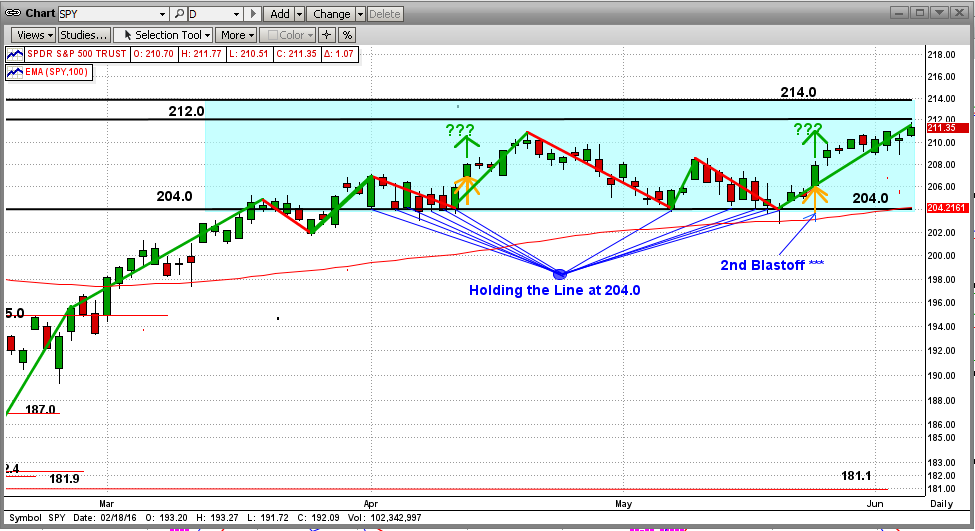
Monday, May 30 2016
After holding again at its very strong 204.0 support level, the SPY "Blasted-Off" again last Tuesday (5/24/16), heading for its all-time closing high at 213.5 (the intraday high is 214.0). If the market breaks above 214.0 (approx. 2140 on the S&P 500 Index), with some degree of strength, we could easily get a 5-10% rally thereafter.
Two things stand in the way of this:
- one is the Fed (surprise, surprise) and
- the other is the SPY's extremely strong resistance at 214.0. This is a very tough one to call, but we have high confidence that MIPS will pick up the trend quickly.
Stay tuned...
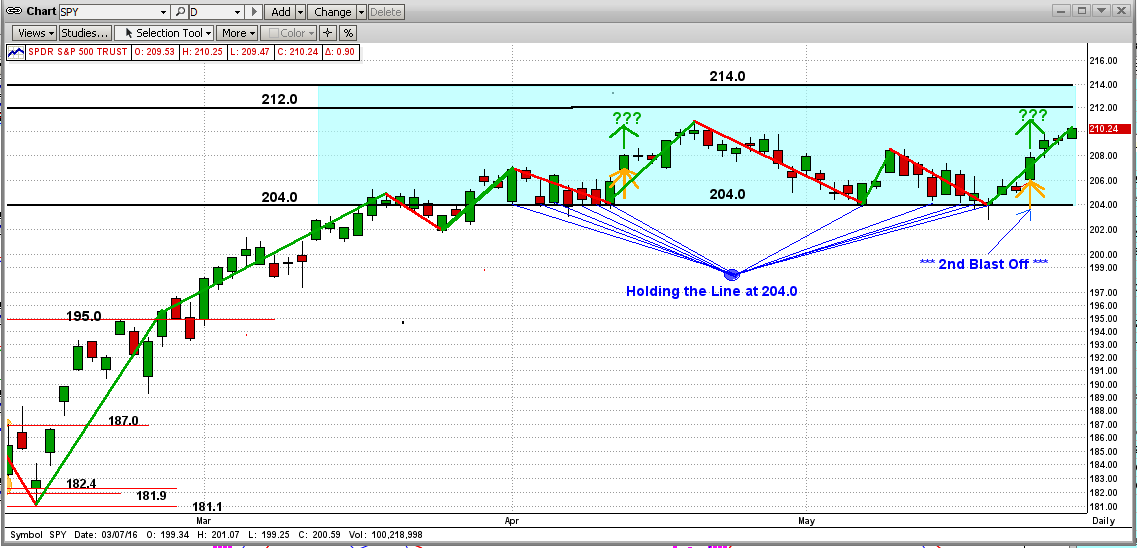
Thursday, May 19 2016
The Fed's big mouth Yellin is yelling and the market is running for the hills. On economic news that should have been good for the market, the Fed once again managed to make it bad news by insinuating the re-start of rate hikes and possibly even more quantitative easing (which would become QE4).
Since the beginning of 2016, the Bulls have fought off all market drops, and the S&P 500 is up for the year. In the last 2 months alone, the Bulls have offered very strong support at 204.0 on the SPY. To be exact, the SPY has amazingly hit and bounced up off of its 204.0 downside support level 12 times in the last two months (see graph below)!!!
We believe that the SPY "break-out" from 204.0 will be volatile and could lead to a major move up or down (i.e., new highs or a market crash). Or course, none of us know for sure which way the market will go from here, but we believe that MIPS will figure it out quickly. Stay tuned and watch closely !!!
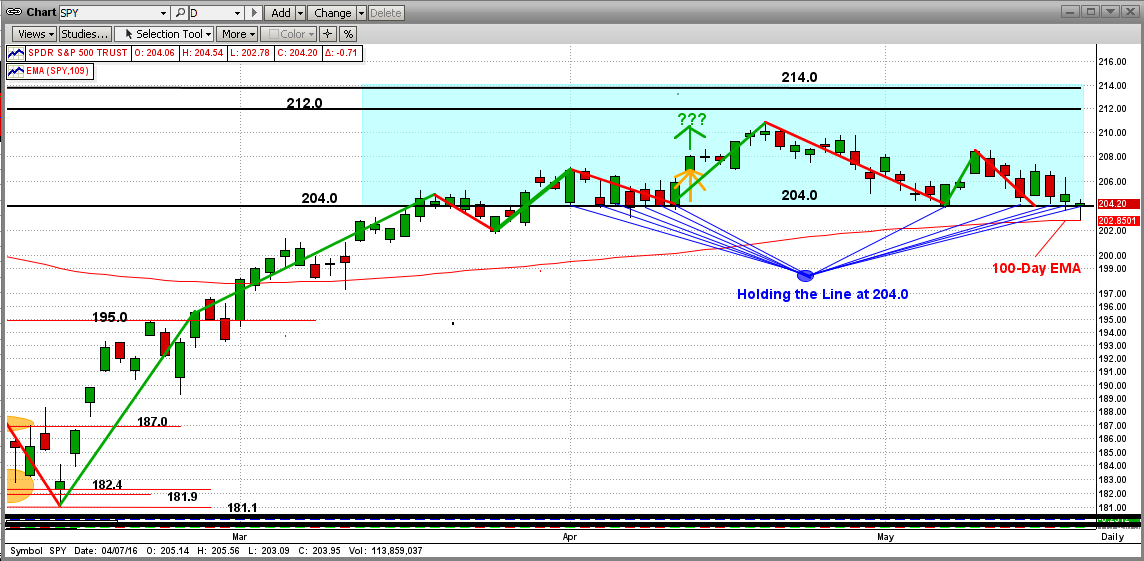
Sunday, May 15 2016
Right above the 2nd graph below, we just added this:
Note: MIPS does not get "fooled" by the lag mentioned above and has called (and should continue to call) the drops/recoveries long before a single indicator like PRICE would. In 2008, MIPS was up over 50% !!!
-------------------------------------------------------------------------------------------------------------------------------
MIPS Members:
We are all wondering where this market will go from here. On Friday of last week, the SPY closed very near a critical point; almost right on the 204.0 support level and dead-on the 50-day EMA (green line in graph below). Of course, in the short-term, the market can move either way from here. We will rely on MIPS to tell us how to trade this market now.
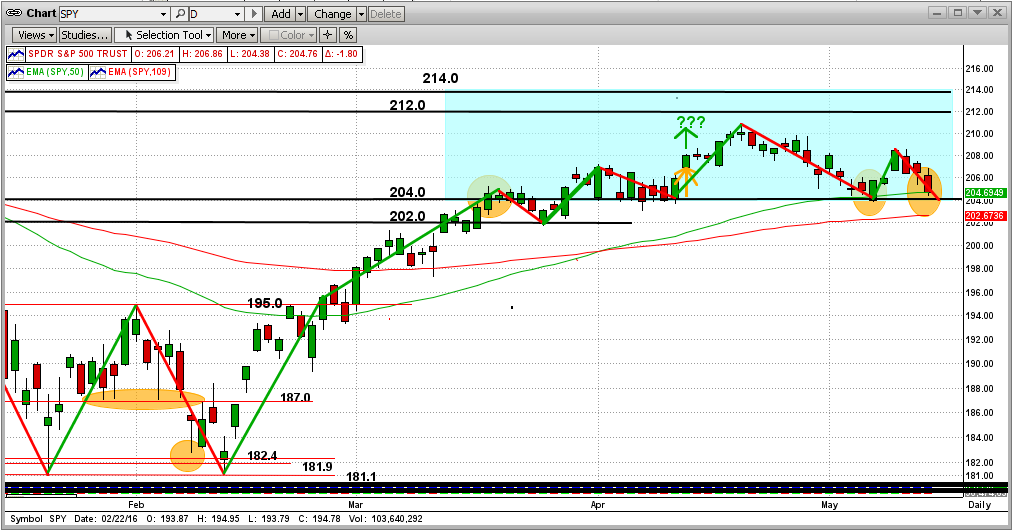
LONG TERM...
At this time, after a 7-year Bull Market, it is interesting and prudent to start analyzing the longer-term outlook. Consider this ...
There are thousands of things that make the stock market move up and down all day long (daily cycles). And, there are others that affect what the market does on a longer-term basis; such as on daily-weekly cycles (short-term), monthly-quarterly cycles (intermediate-term), and annual cycles (long-term).
"Things" that affect short and intermediate-term cycles, (fundamental and technical) are overwhelming, such as:
- natural disasters (earthquakes, tsunamis, etc.)
- terrorist attacks
- foreign crisis (Greece, China, etc)
- tech leader failure (Apple, Amazon, etc.)
- economic growth
- consumer prices
- inflation
- stock values (extreme P/E ratios)
- companies earnings/profits
- Fed Action
- interest rates
- quantitative easing
- dangerously low oil prices
- sentiment
- etc., etc., etc.
Short/Intermediate Term
The above are impossible to predict, but the impact on the market from "all of the above" combined can be measured and analyzed on an intermediate-term basis. That is what MIPS does for us. MIPS uses applied mathematics, pattern recognition, artificial intelligence, and common sense to tell us if the intermediate-term trend is moving up or down. Furthermore, each decision is analyzed in light of what MIPS sees the "big guys" doing (that is, institutional investors, like Morgan Stanley, Goldman Sachs, etc.). MIPS does this by "weighting" market changes by trading volume, using our proprietary "volume-weighted data". Basically, this means that market changes on high volume have a greater impact on decision than market changes on low volume. Of course, since high volume can only come from the big guys, we are basically tracking what the big guys are doing (high volume is like their "foot prints" in the sand).
Long-Term
The long-term trend should be a little easier to predict because of one single indicator. This indicator is NOT a technical indicator. Rather, it is a core fundamental fact which always shows which way the market should/will be moving. I say "should" because it sometimes takes a while to "sink in" (lag); and I say "will" because the market WILL ultimately follow this indicator.
Of course, this is not something that I made up or discovered. Big, smart investors like Warren Buffett have followed this fundamental indicator throughout their entire careers. It's not a new one either, as it was emphasized in Benjamin Graham's book "The Intelligent Investor" in 1949. This non-magical indicator is companies' PROFITS.
Ultimately, the long-term trend in stock prices is driven almost 100% by profits, but sometimes with a few months lag. [I believe that stock prices start moving up or dropping a few months before profits move up or down because the fat kats (CEOs, top management, board members, institutional investors, etc.) know in advance what direction their companies' quarterly profits will be, and they (and their family/friends) take action long before the profits are released to the public.]
Note: MIPS does not get "fooled" by the lag mentioned above and has called (and should continue to call) the drops/recoveries long before a single indicator like PRICE would. In 2008, MIPS was up over 50% !!!
See the graph below (from StockCharts.com and www.RealInvestmentAdvice.com)

BEWARE
In the graph above, you can see that PROFITS "peaked" at the end of 2015, and have been DROPPING for over 1 year now. I believe that the Fed, and only the Fed, has been keeping stock prices high throughout 2015 with quantitative easing and extremely low interest rates. This is not good and cannot continue to happen forever. When the Fed's "tricks" no longer have a positive impact on stock prices, and if the US economy does not improved significantly, we will most likely have a drop in the stock market like in 2000 and 2008 (see graph below).
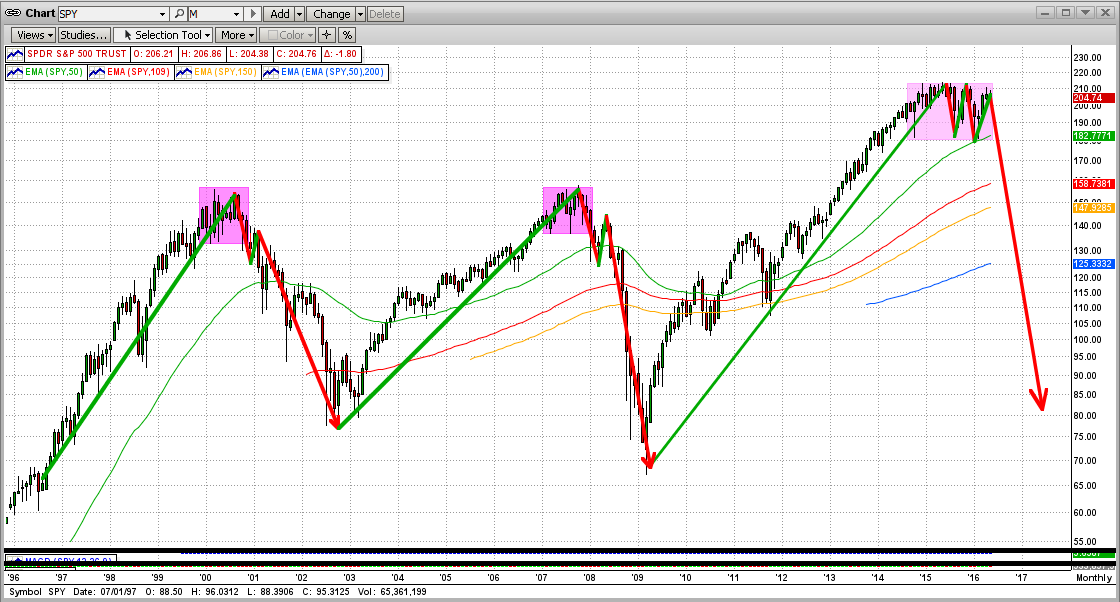
Good trading ...
Sunday, May 15 2016
We are all wondering where this market will go from here. On Friday of last week, the SPY closed very near a critical point - almost right on the 204.0 support level and dead-on the 50-day EMA (green line in graph below). Of course, in the short-term, the market can move either way from here. We will rely on MIPS to tell us how to trade this market now.

LONG TERM...
At this time, after a 7-year Bull Market, it is interesting and prudent to start analyzing the longer-term outlook. Consider this ...
There are thousands of things that make the stock market move up and down all day long (daily cycles). And, there are others that affect what the market does on a longer-term basis; such as on daily-weekly cycles (short-term), monthly-quarterly cycles (intermediate-term), and annual cycles (long-term).
"Things" that affect short and intermediate-term cycles, (fundamental and technical) are overwhelming, such as:
- natural disasters (earthquakes, tsunamies, etc.)
- terrorist attacks
- foreign crisis (Greece, China, etc.)
- tech leader failure (Apple, Amazon, etc.)
- economic growth
- consumer prices
- inflation
- stock values (extreme P/E ratios)
- companies earnings/profits
- Fed Action
- interest rates
- quantitative easing
- dangerously low oil prices
- sentiment
- etc., etc., etc.
Short/Intermediate Term
The above are impossible to predict, but the impact on the market from "all of the above" combined can be measured and analyzed on an intermediate-term basis. That is what MIPS does for us. MIPS uses applied mathematics, pattern recognition, artificial intelligence, and common sense to tell us if the intermediate-term trend is moving up or down. Furthermore, each decision is analyzed in light of what MIPS sees the "big guys" doing (that is, institutional investors, like Morgan Stanley, Goldman Sachs, etc.). MIPS does this by "weighting" market changes by trading volume, using our proprietary "volume-weighted data". Basically, this means that market changes on high volume have a greater impact on decision than market changes on low volume. Of course, since high volume can only come from the big guys, we are basically tracking what the big guys are doing (high volume is like their "foot prints" in the sand).
Long-Term
The long-term trend should be a little easier to predict because of one single indicator. This indicator is NOT a technical indicator. Rather, it is a core fundamental fact which always shows which way the market should/will be moving. I say "should" because it sometimes takes a while to "sink in" (lag); and I say "will" because the market WILL ultimately follow this indicator.
Of course, this is not something that I made up or discovered. Big, smart investors like Warren Buffett have followed this fundamental indicator throughout their entire careers. It's not a new one either, as it was emphasized in Benjamin Graham's book "The Intelligent Investor" in 1949. This non-magical indicator is companies' PROFITS.
Ultimately, the long-term trend in stock prices is driven almost 100% by profits, but sometimes with a few months lag. [I believe that stock prices start moving up or dropping a few months before profits move up or down because the fat kats (CEOs, top management, board members, institutional investors, etc.) know in advance what direction their companies' quarterly profits will be, and they (and their family/friends) take action long before the profits are released to the public.]
See the graph below (from StockCharts.com and www.RealInvestmentAdvice.com)

BEWARE
In the graph above, you can see that PROFITS "peaked" at the end of 2015, and have been DROPPING for over 1 year now. I believe that the Fed, and only the Fed, has been keeping stock prices high throughout 2015 with quantitative easing and extremely low interest rates. This is not good and cannot continue to happen forever. When the Fed's "tricks" no longer have a positive impact on stock prices, and if the US economy does not improved significantly, we will most likely have a drop in the stock market like in 2000 and 2008 (see graph below).

Good trading ...
Sunday, May 08 2016
MIPS Members:
Just as it appeared that the Bulls had broken out to the upside on 4/13/2016 to win the "Resistance Battle" of the SPY at 204.0, the Bears came back strong. The Bulls carried the SPY up to the 211.0 level, but the Bears pushed them back again to test 204.0.
The Bulls fought hard and held above the very strong 204 Resistance Level, which happened to also be the 50-Day EMA. This was a VERY bullish day !
Does this mean the market will be up from here? Absolutely not. It does mean, however, that the Bulls did find the strength to momentarily resist the downward push from the Bears when the market hit the ultra-critical 204.0 resistance.
This market could go either way from here (lots of good reasons now for both directions).
Let's wait for MIPS to tell us what to do !!!
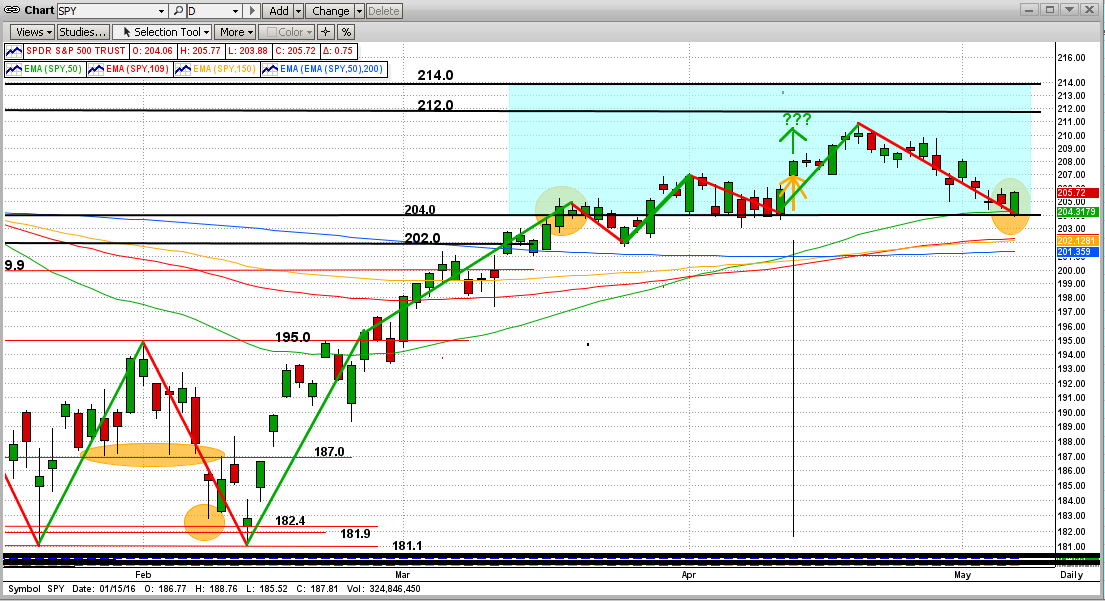
Wednesday, April 13 2016
Did we see the Bulls blast out to the upside today ?
- New run to at least to 212.0 or 214.0 ???
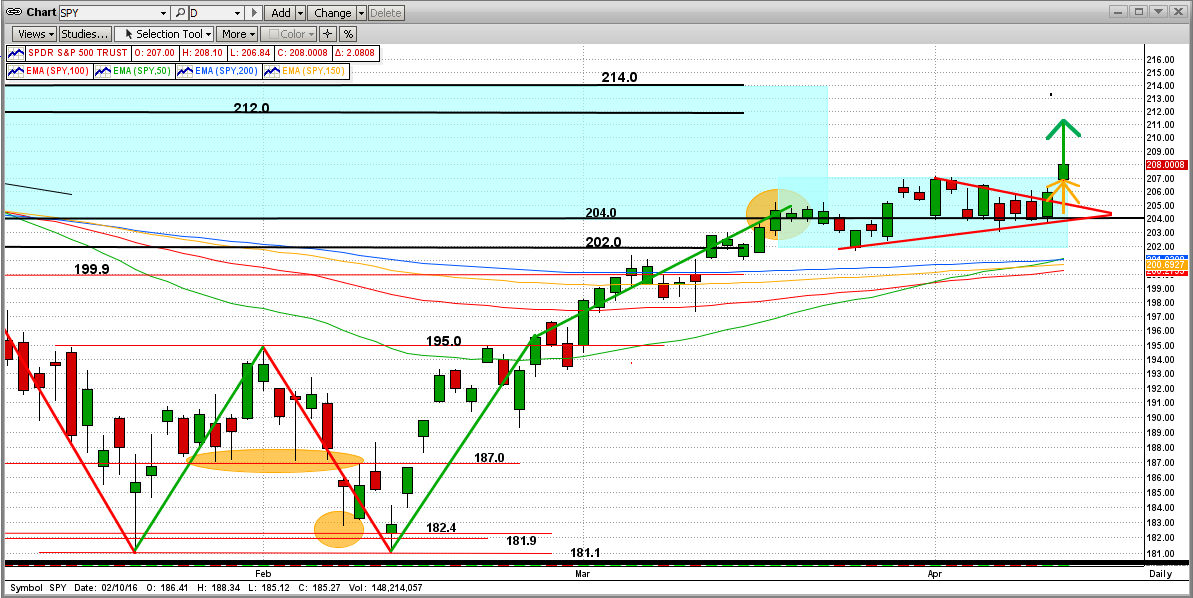
Monday, April 04 2016
Where do we go from here?
The SPY is sitting close to 204, up from about 181. The Bears want to push the SPY back down to 181, but the Bulls want it to continue up to the all-time-high resistance level at 214. When the SPY hit 204, it was like hitting a triple-reinforced brick wall (with lots of waffling around since then). "The Battle of 204" will turn out to be quite a battle.
Lots of people are simply peeking over the fence (watching) to see what might happen next, but MIPS is "in the gears" analyzing (calculating) what is most likely to happen next. I'm betting on MIPS !!!
PEEKING...

MIPS'ing...
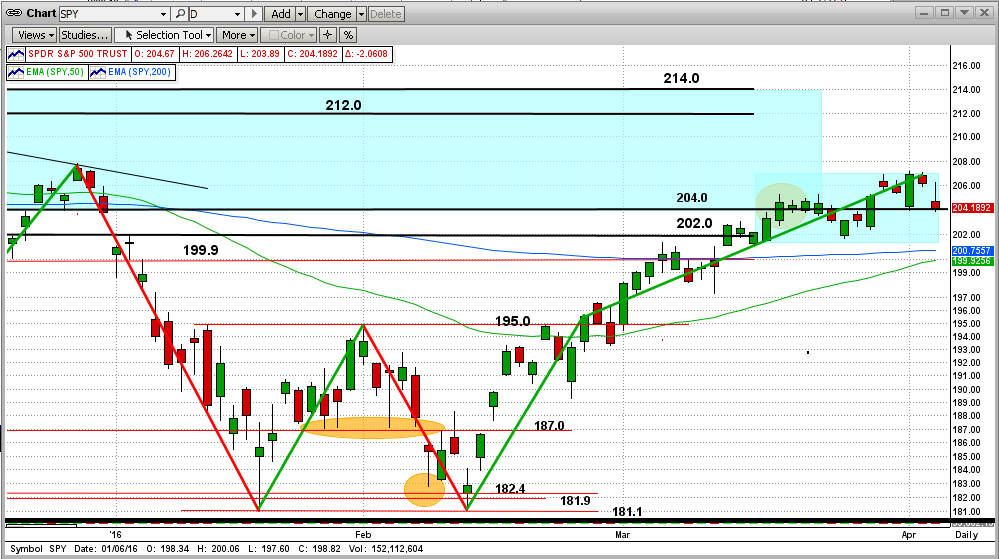
|